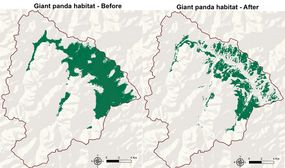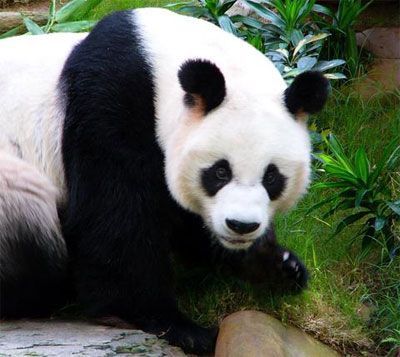
Good news is hard to come by these days, but here's a little: China's wild panda numbers are up! In 2016, the bamboo-eating giant panda (Ailuropoda melanoleuca) native to southern central China was reclassified as "vulnerable" by the International Union for Conservation of Nature (IUCN), after spending nearly 30 years on the "endangered" list. The species' wild population has grown by 17 percent in the past decade, bringing its numbers up to more than 1,800 pandas living in the wild, according to the most recent census.
And although this is terrific news, two new pieces of research show risk still exists for the giant panda due to infrastructure development and livestock grazing.
Advertisement
The first new study, published in the Sept. 25, 2017, issue of the journal Nature Ecology and Evolution, looks at what brought about this population growth, and whether it's likely to continue.
"What my colleagues and I wanted to know was how the panda's habitat has changed over the last four decades, because the extent and connectivity of a species' habitat is also a major factor in determining its risk of extinction," said coauthor Stuart Pimm, professor of conservation ecology at Duke University's Nicholas School of the Environment, in a press release.
The researchers used satellite imagery data to figure out the change in land use over the panda's entire geographic range. They found that between 1976 and 2001, panda habitat decreased by 23 percent — but that it actually increased slightly between 2001 and 2013. This encouraging trend has been due mostly to bans on commercial logging in panda habitat, as well as the establishment of 67 panda preserves and education for people living within these preserves.
But the changes in these panda-friendly areas of China haven't all been good: Loads of new infrastructure like roads and hydropower stations has been built since 2001.
"These have been the major factor in fragmenting the habitat," said Pimm. "There was nearly three times the density of roads in 2013 than in 1976."

Although there's no aingle permanent solution to securing the conservation of these iconic animals, the research team suggests establishing panda corridors between the existing patches of habitat. That would allow the remaining wild pandas to find each other, and prevent any part of the population from becoming isolated.
A separate cooperative research initiative conducted by Chinese and U.S. scientists looked at the impact of livestock on panda habitats. The second study, published online Oct. 3, 2017, in the journal Biological Conservation, found that over the past 15 years, livestock numbers in China's Wanglang National Nature Preserve have increased 900 percent, damaging one third of all giant panda habitat in the park.
"These problems are not unique to our study area, but common throughout the panda nature reserves and habitats. It is not just an ecological problem, but also a gamble between the communities, the nature reserves, local governments and other stakeholders," added Li Sheng, an assistant professor of conservation biology at Peking University involved in the second study.
"This long-term monitoring shows that the pandas are being driven out of the areas that are heavily used by the livestock, especially the park's valleys," said Pimm, who participated in research for both studies. "These lower elevation areas are crucial for giant pandas, especially during winter and spring."
Advertisement

